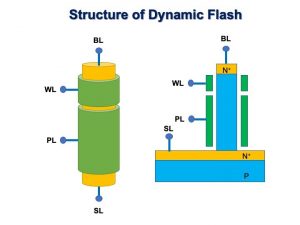
Unisantis, founded in 2008 by the inventor of flash technology Fujio Masuoka, has patented surround gate transistor (SGT) technology, a 3D transistor design which offers significant system design and performance advantages to the manufacturers of memory and image sensor semiconductors and scales to very small nodes.
DRAM’s challenge has long been to continue packing in more storage for lower cost, without increasing power consumption, argues Unisantis, DFM takes a revolutionary approach to overcome limitations of conventional volatile memory such as DRAM, with its inherent short, regular and power-hungry refresh cycles, as well as destructive read processes.
DFM is also a type of volatile memory, but since it does not rely on capacitors it has fewer leak paths, it has no connection between switching transistors and a capacitor. The result is a cell design with the potential for significant increases in transistor density and, because it not only offers block refresh, but as a Flash memory it offers block erase – DFM reduces the frequency and the overhead of the refresh cycle and is capable of delivering significant improvements in speed and power compared to DRAM.
By utilizing TCAD simulation, Unisantis has proven DFM has a substantial potential to increase density 4X compared to DRAM. The scaling of DRAM has almost stopped at 16Gb, according to recent IEEE ISSCC (International Solid-State Circuits Conference) papers.
Modelling DFM at 4F2 cell density shows how perfectly structured DFM is (see 4F2 cell image here). The design and development of DFM means significant Gb/mm2 improvements, and today’s limits on DRAM (currently 16Gb) could immediately see increases to 64Gb memory using DFM’s radically enhanced cell structure.
Replacing DRAM is a major challenge for the industry, not only because DRAM today accounts for over 50% of the current market demand for memory (Yole Development, 2020). Forecasts also suggest the need for this type of low cost, high density DRAM by 2025 will continue to grow and exceed $100Bn. But technology challenges also lie ahead presented by some of the proposed replacements, including capacitor-less DRAM, ZRAM or simplistic GAA and Nanosheet approaches, all which have their own limitations compared to DFM.
DFM was developed by Unisantis with the proven technological principles of SGT Technology building on that work and the company’s innovations, particularly in memory semiconductors